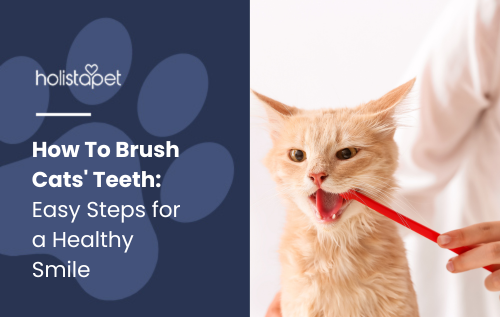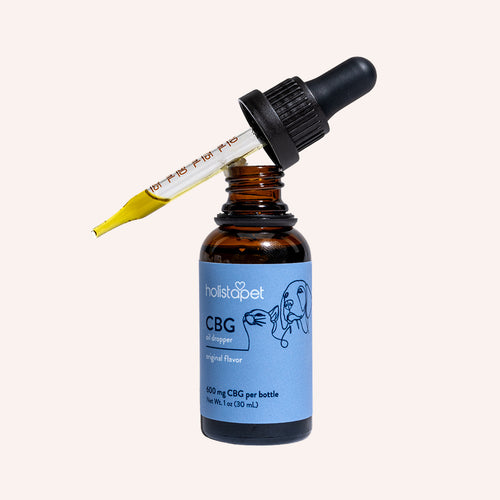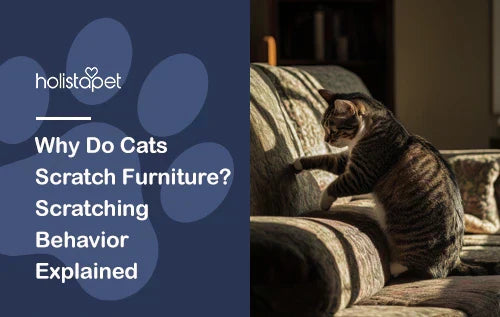Wondering how to brush a cat's teeth properly? Luckily for us, it's not as tricky as it seems!
Dental care, including tooth brushing, is essential to your feline friend's overall health. Regular brushing helps prevent dental problems, like tartar buildup and gum disease, which can lead to painful tooth loss.
It might take some time to get your kitty to accept tooth brushing as part of their routine, but with the right steps, they can soon flaunt a fresh, healthy smile. So, grab your cat's toothbrush and some cat toothpaste, and let's make brushing a breeze!
Why Brushing Cats' Teeth Matters

Brushing is more than just a beauty routine; it's a health necessity. Keeping your cat's chompers clean helps prevent dental disease, which is super common in felines, especially as they age.
Plaque and tartar can build up quickly, leading to gum issues and tooth loss. By brushing regularly, you can avoid these problems and keep your cat's mouth fresh and clean.
Healthy teeth mean fewer vet visits and a happier, healthier kitty. Plus, it's an easy way to show them you care, one tooth at a time!
How Often Should You Brush Your Cat's Teeth?
Ideally, you should brush them every day, as daily brushing is the best way to prevent plaque and tartar buildup. If that's not possible, aim for at least three times a week to maintain their dental health.
Regular cleaning keeps your kitty's mouth fresh, prevents bad breath, and can save you from costly dental procedures down the road. Make brushing a part of your furry friend's daily routine, and they'll thank you with a healthier smile.
How To Brush Cat Teeth: Step-By-Step Guide
Cleaning your cat's teeth might seem intimidating, but there's no need to sweat. Follow this simple guide to make the task as smooth and stress-free as possible:
-
Get the Right Tools.Use a cat-specific toothbrush and toothpaste.Human toothpaste isn't safe for cats,so make sure you pick up pet toothpaste.
-
Start Slow. Gently rub your cat's gums with your finger first to get them comfortable with the sensation.
-
Introduce the Toothbrush. Gradually introduce the toothbrush, letting your cat sniff and get used to it before brushing.
-
Brush Gently. Use a soft, circular motion to brush the teeth's surfaces. Focus on the gum line where plaque tends to build up.
-
Reward Time. After brushing, reward your kitty with a treat or some playtime. This helps them associate the event with something positive.
Choosing the Right Cat Toothbrush and Toothpaste

Choose a toothbrush designed specifically for cats. These typically have softer bristles and a smaller head for easy access to those tricky back teeth. You can choose from finger toothbrushes, small brushes, and micro-head brushes.
For toothpaste, avoid human brands! They contain fluoride, which isn't safe for felines. Instead, opt for pet toothpaste, often available in tasty flavors like chicken or tuna, so your kitty actually enjoys the experience.
Getting Your Cat Comfortable With Tooth Brushing
Start by gently holding your cat's head and touching their mouth and teeth with your finger. This helps them get used to the sensation. Once they're relaxed with this, introduce the toothbrush slowly. Let them sniff and investigate it first. Don't rush!
Keep each session calm and short, just a few seconds at a time, gradually increasing as they get more comfortable. With consistency and positive reinforcement, like treats or cuddles after each session, most cats start to accept brushing as a regular part of their routine.
Brushing Cats' Teeth the Right Way
First, always focus on the outer surfaces of their teeth, as these are the areas where plaque and tartar accumulate most. Use a soft-bristled toothbrush to gently clean in a circular motion.
Don't forget to get around the gums. This is where dental problems like periodontal disease can start. Avoid brushing too hard to prevent irritation in this sensitive area.
And remember, consistency is key! A little cleaning every day can go a long way in keeping your kitty's smile healthy and bright.
How To Keep Cats Calm While Brushing Teeth
Start by creating a calm and quiet environment. Avoid distractions, and try brushing after a play session when your kitty is already tired and relaxed. If your cat tends to get anxious, consider wrapping them in a towel to keep them still without causing stress.
Take your time, and don't rush the process. Keeping the sessions short and gentle helps prevent overwhelming your pet. Regular, positive experiences will help them associate dental care with something calm and pleasant, making each session easier for both of you.
Natural Calming Remedies Like CBD for Teeth Brushing
Natural calming remedies lik CBD (cannabidiol) might be just what you need to keep your kitty calm during brushing sessions. CBD has calming properties, helping reduce nervousness and agitation in pets. It works with your cat's endocannabinoid system (ECS) to help regulate things like mood, pain response, and internal balance.
HolistaPet's calming CBD products for cats—from our soft chews to our crunchy treats, oils, and capsules—can provide soothing effects. These products are specifically designed to help calm agitated or nervous behaviors without any harmful side effects. Just a few drops or treats before a cleaning session could make all the difference in keeping your feline friend calm and comfortable.
Signs of Dental Issues in Cats
Not sure if your pet's teeth are in trouble? Look out for these signs of dental issues, which could indicate your kitty needs a trip to the vet:
-
Bad Breath. Foul odor could be a sign of tartar buildup or gum disease.
-
Excessive Drooling. If your cat is drooling more than usual, it could mean something's wrong with their teeth or gums.
-
Difficulty Eating. If your pet avoids food or shows reluctance to chew, tooth pain could be the issue.
-
Red or Swollen Gums. Inflamed gums are a common sign of periodontal disease.
-
Tooth Loss. Dental problems, when left untreated, can lead to missing teeth and other severe issues.
Alternative Ways To Support Your Cat's Dental Health

Brushing your cat's teeth is not the only way to keep their dental health in check. There are other great approaches to help support their oral care routine. Cat dental chews and treats are a fun way to help reduce plaque and tartar buildup while giving your kitty something they enjoy.
You can also look into dental products like water additives or sprays that promote clean teeth and gums. These alternatives work alongside brushing, making sure your pet's smile stays healthy and bright. So, why not add a few extra steps to their dental routine to keep their pearly whites shining?
Dental Treats and Chews
Dental treats and chews are specially formulated treats that help scrape away plaque and prevent tartar buildup as your cat chews. Many dental chews contain ingredients that promote oral health while also being delicious enough to keep your feline friend entertained.
Just be sure to choose treats that are specifically designed for dental care, as some regular treats may not be as effective. Adding dental chews to your cat's routine gives them a tasty way to maintain their teeth between brushings. It's a win-win for both of you!
Water Additives and Dental Sprays
Water additives and dental sprays are easy to use. Just add the recommended amount to your cat's water bowl or spray directly onto their teeth and gums. They're designed to help reduce plaque and tartar buildup while freshening your pet's breath.
Many of these products use safe, natural ingredients like enzymes that help fight bacteria in your cat's mouth. While water additives and sprays shouldn't replace tooth brushing, they're a fantastic addition to your kitty's overall dental care routine. Plus, they make oral care even easier for both you and your furry friend.
Common Mistakes To Avoid When Brushing Cats' Teeth
There are a few common mistakes you'll want to avoid to make the brushing process smoother and more effective. Keep these don'ts in mind:
- Using Human Toothpaste. Always use toothpaste made specifically for cats. Human toothpaste contains ingredients that are harmful to our feline friends.
- Brushing Too Hard. Cats have sensitive gums, so brushing too hard can cause discomfort or damage.
- Skipping the Gums. Be sure to brush along the gum line where plaque tends to build up. Ignoring this area can lead to tartar and gum disease.
- Not Being Consistent. Dental health requires regular care, so don't skip brushing sessions. Aim for at least a few times a week to keep their chompers clean.
Final Tips for a Stress-Free Brushing Routine
Wrapping up your cat's tooth-brushing routine? Here are some final tips to keep things stress-free for both you and your feline friend:
-
First, try to make tooth brushing a positive experience by giving plenty of praise and treats afterward.
-
Keep the sessions short, and always stay patient. Cats take time to get used to new routines.
-
If your cat becomes too fidgety or anxious, try calming remedies like CBD to help them relax before you start brushing. HolistaPet's calming CBD products are a great option to help reduce nervousness and create a calm environment.
With these tips, brushing your cat's teeth will become a breeze. You can make sure their dental health stays in top shape!


 CBD Oil for Cats - Fast Acting
CBD Oil for Cats - Fast Acting
 CBD Cat Treats - Easy Dose
CBD Cat Treats - Easy Dose
 CBD Calming Chews for Cats - Highly Rated
CBD Calming Chews for Cats - Highly Rated
 CBG Oil for Dogs and Cats - Loved by Thousands
CBG Oil for Dogs and Cats - Loved by Thousands


![Cat Upset Stomach Relief: Foods & Remedies That Work" by [Author Name]. Shows a cat eating food and remedies to soothe its upset stomach.](http://www.holistapet.com/cdn/shop/articles/Cat_Upset_Stomach_Relief_23e41c91-bed2-47bf-b9be-3f9ecd9b4853.png?v=1748469619&width=500)


Leave a comment
All comments are moderated before being published.
This site is protected by hCaptcha and the hCaptcha Privacy Policy and Terms of Service apply.